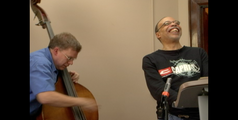“What I Call a Sound”: Anthony Braxton’s Synaesthetic Ideal and Notations for Improvisers
Graham Lock
Published: 2008-05-04
In this article I look at some of the visual elements in Anthony Braxton’s music and examine how he uses graphic and symbolic notations in particular to initiate fresh approaches to improvisation.
Drawing on a previously unpublished interview in which he describes his perceptions of sound, I consider the possibility that Braxton may be a synaesthete who has “colour hearing”. However, since this question appears irresolvable, I focus instead on his music, which certainly embodies a “synaesthetic ideal”, in which sound, colour and shape (and other factors) all correspond, and I trace the possible origins of, and reasons for, this ideal in Braxton’s mystical beliefs and in the upsurge of a synaesthetic culture in fin de siècle European Romanticism.
In the second half of the article, I look at some specific examples of Braxton’s alternative notations and, via reference to his Composition Notes and Tri-axium Writings, I explore how his uses of the visual also reflect the values and methodologies he ascribes to the African American creative music tradition, in which “individual presence” (of the participants), as expressed through improvisation, is a crucial factor in performance practice.
Finally, I suggest that this mixing of African American and European Romantic influences exemplifies Braxton’s claim that his music is “trans-idiomatic”; that is, it cannot be categorised within any one musical or ethnic tradition, but rather synthesises elements from all.


